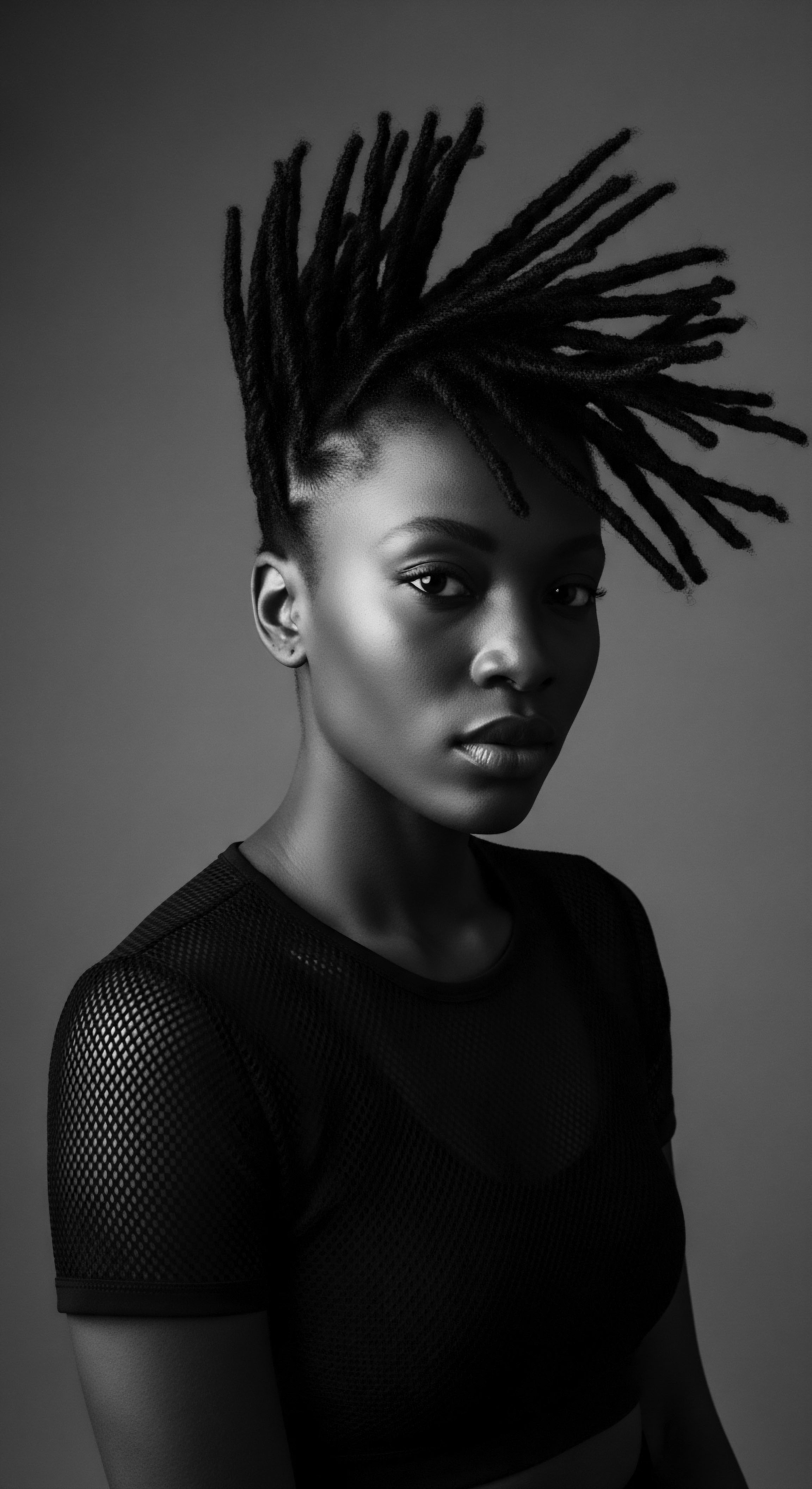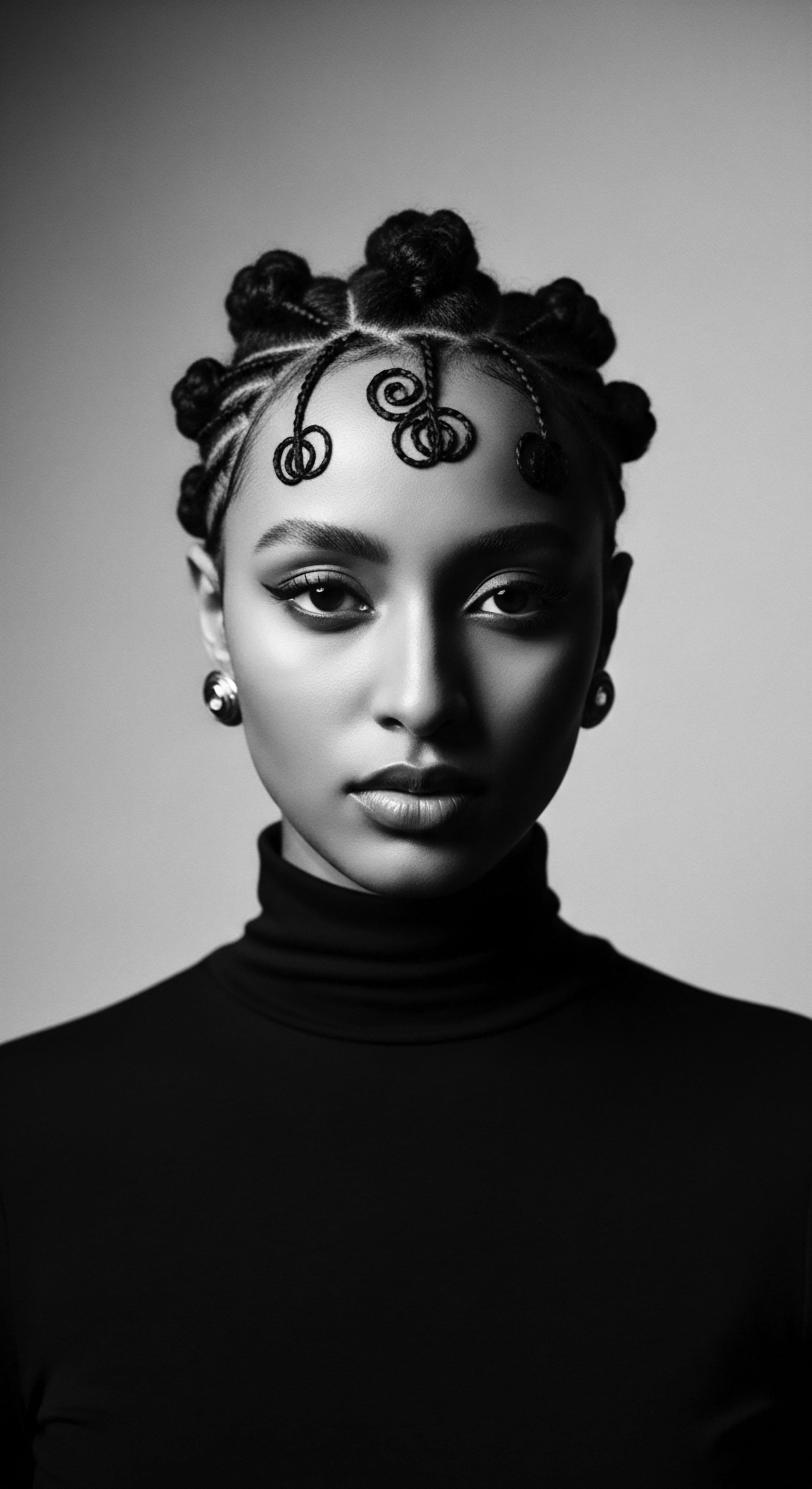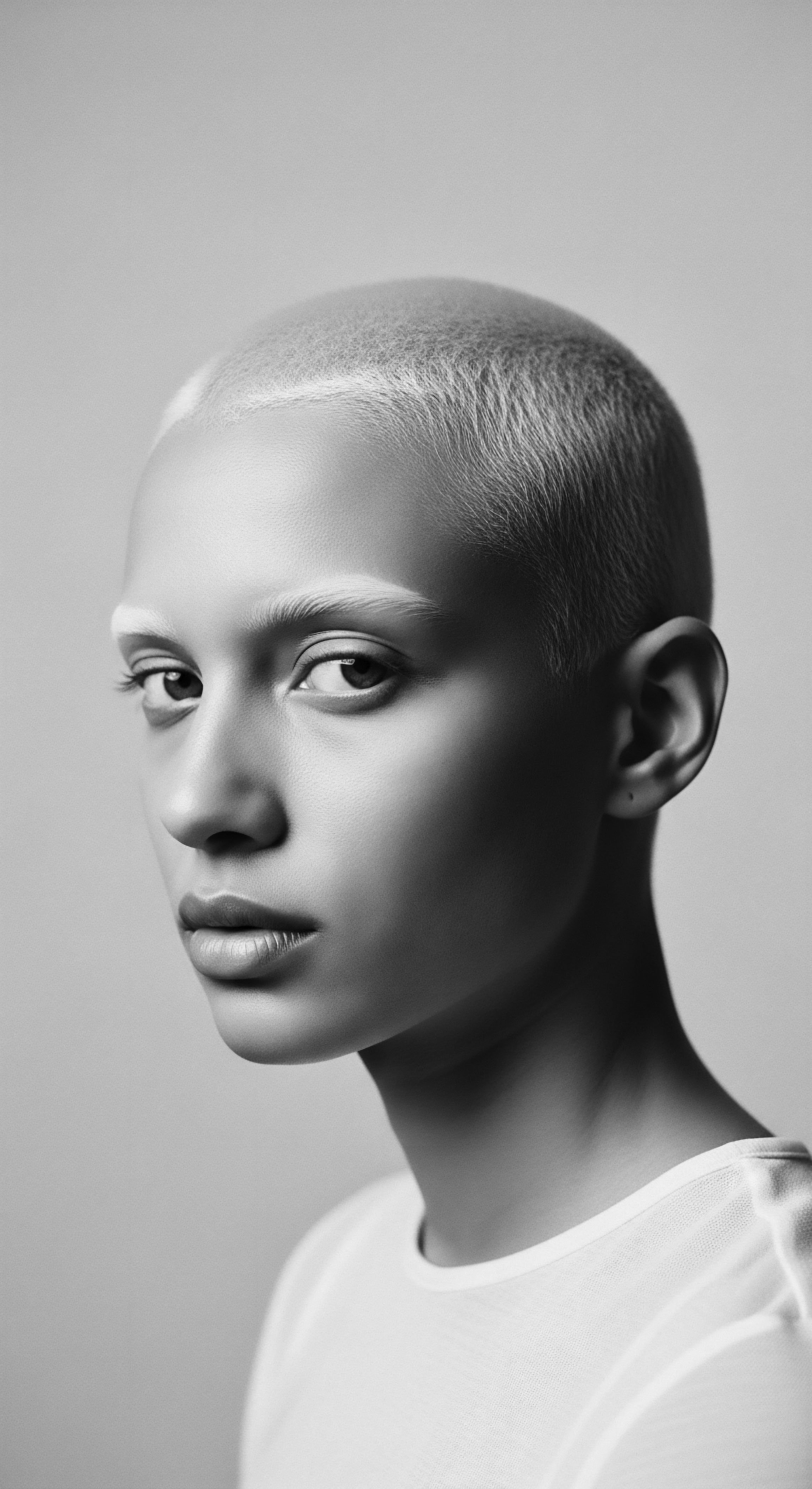
Roots
To truly comprehend how the designs of ancient combs served the needs of textured hair, one must journey back to the very origins of our strands, to the ancestral lands where hair was more than mere adornment; it was a living chronicle. Consider, if you will, the intimate dance between the human hand, raw material, and the coiling, spiraling, and tightly wound formations that crown so many of us. This is not a distant, academic inquiry; it speaks to the very rhythm of our being, a legacy etched in every curve of a comb tooth, every span between its prongs. It invites us to listen to the whispers of ancient hands, understanding that their ingenuity was born from a profound, inherited understanding of hair’s unique character.
The foundation of this understanding lies in the elemental biology of textured hair, viewed through a historical lens. From the earliest human civilizations, particularly across Africa, individuals cared for hair that possessed distinct anatomical features. Unlike straight or wavy hair, tightly coiled hair strands often exhibit an elliptical or flattened cross-section, contributing to their remarkable elasticity and their tendency to clump and coil. This inherent structure creates a challenge for disentangling and styling without causing breakage.
Ancient peoples, with their deep connection to the natural world and keen observational skills, intuitively recognized these properties. Their tools, therefore, became extensions of this awareness, fashioned with an understanding of how to honor and work with hair’s inherent curl patterns rather than against them.
Ancient combs were not just tools; they were reflections of deep, ancestral understanding of textured hair’s fundamental nature.
Early combs unearthed from sites like Predynastic Egypt (Kemet) and Kush, dating back as far as 6,000 to 7,000 years, reveal designs that speak directly to the demands of Afro-textured hair. These artifacts, often carved from wood, bone, or even hippopotamus ivory, display characteristics essential for navigating dense, coily strands without causing damage. The significant spacing between the teeth and the sometimes considerable length of the prongs are direct responses to the hair type these communities possessed.
Such design choices minimized snagging, facilitated gentle detangling, and aided in manipulating hair into intricate styles. These early tools were, in essence, the first ‘wide-tooth combs,’ designed by necessity and refined by generations of practice.

What Did Early Comb Designs Tell Us About Hair Anatomy?
The very morphology of ancient combs provides a window into how historical populations understood the anatomy of the hair that grew from their scalps. The earliest combs were, in many instances, what we might term ‘picks’ – tools with long, widely spaced teeth. This form speaks to a direct appreciation of the hair follicle’s unique output in textured hair ❉ a strand that grows with a distinct curl pattern from its root.
Attempting to comb such hair with fine, closely spaced teeth would result in significant resistance, discomfort, and inevitable breakage. Therefore, the architectural choice of broader gapping between prongs points to an instinctive, empirical understanding of curl patterns and their need for minimal friction during manipulation.
Consider the simple act of detangling. For many with tightly coiled hair, this process demands a tool that can glide through clumps of curls, separating them without tearing. The wide gaps on these ancient combs allowed for this gentle separation. Furthermore, some early combs featured dual sides, with one side having coarser teeth and the other finer.
This dual design suggests a nuanced approach to hair care, acknowledging that different sections or stages of hair manipulation might require varied levels of detangling or smoothing. It points to a sophisticated knowledge of hair care practices that extended beyond mere functionality into a realm of responsive design.
- Wide Spacing ❉ Ancient combs from African regions often featured generously spaced teeth, facilitating gentle detangling and minimizing breakage for coily and kinky hair types.
- Long Prongs ❉ The elongated teeth of many early combs allowed for deeper penetration into dense hair, aiding in styling and scalp stimulation.
- Robust Materials ❉ Carved from materials like wood, bone, and ivory, these combs possessed the strength and durability required to withstand the tension of textured hair.

How Did Ancient Lexicons Inform Comb Design?
While we do not have direct transcripts of ancient conversations about hair, the tools themselves become part of a silent lexicon, speaking volumes about the terms and understandings that shaped their creation. If a community had terms for ‘coils,’ ‘knots,’ or ‘matted hair,’ it stands to reason their tools would be designed to address these specific conditions. The term ‘afro pick,’ though modern, echoes the ancient function of these combs ❉ to lift, to separate, to create volume and shape within a natural, unstraightened hair form. The very presence of these ‘pick’-like forms in antiquity suggests a long-standing appreciation for the hair’s natural volume and texture.
Moreover, the intricate carvings and symbols found on the handles of many ancient combs, particularly those from African societies, suggest their role transcended mere utility. These were not simply ‘hair tools’; they were often artifacts of status, identity, and spiritual significance. The symbology etched into wood or ivory could communicate tribal affiliation, social standing, fertility, or even provide spiritual protection. The design of the comb was intrinsically tied to the meaning it conveyed, making it a tangible representation of a community’s heritage and its relationship with hair.
| Comb Feature Widely spaced, long teeth |
| Inferred Need of Textured Hair Gentle detangling, reduced breakage for dense curls. |
| Heritage Significance Ancestral knowledge of hair fragility and strength. |
| Comb Feature Robust materials (wood, bone, ivory) |
| Inferred Need of Textured Hair Durability for consistent use on resilient strands. |
| Heritage Significance Resourcefulness, connection to natural materials. |
| Comb Feature Dual-sided design (coarse & fine) |
| Inferred Need of Textured Hair Versatility for various hair states or styling stages. |
| Heritage Significance Sophisticated, nuanced approach to hair care. |
| Comb Feature Decorative handles, symbolic carvings |
| Inferred Need of Textured Hair Identification, status, spiritual connection. |
| Heritage Significance Hair as a marker of identity, community, and belief. |
| Comb Feature These ancient designs were born from practical needs and deeply held cultural values, revealing a profound respect for textured hair. |

Ritual
The care of textured hair, throughout history, has always extended beyond simple grooming; it has been a sacred ritual, a communal practice, and a profound act of self-expression. Ancient comb designs, rather than existing in isolation, were central instruments within these established customs, enabling the creation and maintenance of styles that held deep cultural resonance. The very act of combing became a moment of connection, passing down traditions from one generation to the next, preserving a heritage that braided history into every strand.
Consider the protective styles so prominent in African and diasporic hair traditions. Braids, twists, and various forms of coiling offered not only aesthetic beauty but also preserved the hair from environmental elements and daily wear. The design of ancient combs directly supported the creation of these enduring forms.
Their long, robust teeth were ideal for sectioning hair, separating strands for braiding, and gently lifting the scalp to aid in cleansing. Without tools capable of navigating the inherent density and elasticity of textured hair, the intricate architecture of styles like cornrows or elaborate coiled patterns would have been exceedingly difficult to achieve.

Did Ancient Combs Support Protective Styling?
Yes, indeed. The archaeological record, particularly from regions of ancient Africa, shows combs that were uniquely suited to the requirements of protective styling. These styles, such as tightly woven braids or threaded hair, served multiple purposes ❉ protection from sun and dust, preservation of moisture, and a foundation for elaborate adornments.
The combs facilitated this by providing the necessary leverage and separation. The robust nature of many ancient combs, often carved from durable wood or bone, meant they could withstand the tension involved in sectioning and manipulating dense hair, unlike more delicate tools.
Ancient combs were integral to the ancestral creation of protective styles, providing the necessary precision and strength for intricate hair architecture.
One striking example lies in the broader spaced teeth of many African combs compared to their European counterparts from similar periods. A study of combs from Kemet (ancient Egypt) and those found at the Dawu site in Ghana highlights that the wider gaps in African combs were likely a conscious design choice, recognizing the fragility of African-type hair and its propensity for breakage if handled roughly. This adaptation underscores a profound, functional relationship between comb design and the specific needs of textured hair, directly supporting styles that minimized daily manipulation and offered prolonged protection. The wide-toothed comb, in essence, is an ancestral technology for hair health.
The influence of these tools on styling practices extended to more than just foundational sectioning. They also aided in maintaining the definition of natural curls and coils. After washing or oiling, the wide teeth could gently separate strands without disrupting the natural curl pattern, allowing for air drying or the application of natural pomades.
This would help in setting the hair into its desired shape, whether loose or prepped for a more structured style. This highlights a continuity of practice where the comb served not only for detangling but also for shaping and preserving the hair’s inherent beauty.
- Sectioning Hair ❉ The long, sturdy teeth allowed for precise and clean parting of hair, a fundamental step in creating braids, twists, and other structured styles.
- Gentle Detangling ❉ Wide spaces between teeth prevented snagging and breakage, preserving the integrity of individual hair strands during manipulation for styling.
- Styling Aid ❉ Combs helped in lifting, shaping, and defining coils, contributing to the volume and aesthetic of natural hairstyles.

How Did Combs Shape Adornment and Social Status?
Beyond the purely practical, ancient combs held a significant place in the realm of adornment and the articulation of social status. In many African societies, hair was a powerful medium for non-verbal communication, signaling age, marital status, tribal identity, and even wealth. The combs used to style and maintain these significant coiffures were often themselves objects of art and markers of prestige.
Archaeological finds from Ancient Egypt, for instance, include combs crafted with exquisite detail from materials such as wood, bone, and ivory, sometimes decorated with animal figures like gazelles or birds. These were not simply utilitarian items; they were symbols of craftsmanship and refinement, often found in tombs as part of burial offerings, signifying their importance in both life and the afterlife. The existence of such elaborate combs suggests that the act of hair care and styling was often elevated to an artistic and ceremonial level.
Consider the broader cultural context. In many traditional African communities, hairdressing was a communal activity, a time for sharing stories, wisdom, and strengthening social bonds. The combs used within these intimate settings were not mere accessories; they were imbued with the spirit of these shared moments.
They were instruments of connection, facilitating the transmission of ancestral knowledge about hair care and cultural identity. The comb, in this sense, becomes a silent storyteller, its form and adornment echoing the human interactions and social structures it once served.
| Time Period & Region Predynastic Egypt (Kemet), Kush (6000-7000 BCE) |
| Typical Materials Wood, bone, hippopotamus ivory |
| Associated Cultural Meaning Utilitarian, status symbol, burial offering, artistic expression, connection to nature. |
| Time Period & Region Ancient Greece & Rome |
| Typical Materials Metal, boxwood, ivory |
| Associated Cultural Meaning Grooming, hygiene (lice prevention), personal cultus, less specific to textured hair needs. |
| Time Period & Region Medieval Europe |
| Typical Materials Horn, ivory, metal |
| Associated Cultural Meaning Hygiene, social status, increasingly decorative for the elite. |
| Time Period & Region West Africa (Pre-colonial) |
| Typical Materials Wood, metal, carved bone |
| Associated Cultural Meaning Status symbol, tribal identity, religious belief, tools for protective styles. |
| Time Period & Region 19th-20th Century (Diaspora) |
| Typical Materials Wood, metal, early plastics |
| Associated Cultural Meaning Identity reclamation, political symbol (e.g. 'Black Fist' comb), adaptation to new environments. |
| Time Period & Region Materials and embellishments on combs varied by culture and era, always reflecting their practical and symbolic significance within society. |

Relay
The continuity of comb design across millennia, particularly in tools tailored for textured hair, stands as a testament to an enduring ancestral wisdom. The principles understood by ancient civilizations—the necessity for wide teeth, robust materials, and purposeful ergonomics—were not lost to time. Instead, they were relayed across generations and geographies, evolving in form but retaining their core functionality. This continuous line of development from the earliest ‘picks’ found in ancient African contexts to contemporary wide-tooth combs speaks to a profound scientific intuition, long before modern trichology offered its explanations.
The very physics of coily hair dictates that strands can become interlocked, forming tangles that are incredibly resistant to friction. Applying a comb with fine, closely packed teeth to such a structure acts like a series of tiny shears, causing breakage and damage. The ancient African comb, with its distinctive long, widely spaced teeth, directly mitigated this physical reality.
This design allows for the gentle separation of coils, guiding them along their natural curl pattern rather than forcing them into an unnatural alignment. The tool, in essence, respects the hair’s inherent biology, validating an understanding of strand dynamics that modern science now confirms.

Did Ancient African Combs Shape Later Designs for Textured Hair?
Archaeological findings and ethnographic comparisons strongly suggest that ancient African comb designs laid a foundational blueprint for tools serving textured hair globally. The earliest combs resembling what we now call ‘afro combs’ or ‘picks,’ characterized by their long, widely-spaced teeth, have been found in Predynastic Egypt and Sudan, dating back 6,000 to 7,000 years. These early tools demonstrate an understanding of the unique requirements for managing dense, coily hair.
The wide-toothed comb, an ancestral design, speaks to a timeless understanding of textured hair’s delicate structure and needs.
One compelling case study illustrating this enduring design influence is the remarkable similarity between combs excavated from the Dawu site in Ghana (dating to the 17th-18th centuries CE) and much older Predynastic Egyptian combs. K.N. Chimbiri, in “Secrets of the Afro Comb ❉ 6,000 Years of Art and Culture,” discusses how a comb from Dawu is almost identical to a comb from Ancient Kemet, found in Abydos, which is around 6,000 years old. This striking resemblance across continents and millennia points to a shared ancestral knowledge and adaptation, demonstrating that enslaved African people in the Americas continued to create and use tools that mirrored those from their homelands, often under difficult circumstances.
This continuity speaks to the effectiveness and cultural significance of these designs, persisting through displacement and forced cultural erasure. The function and form were too essential to abandon.
The re-emergence of the ‘afro pick’ in the mid-20th century, during the Black Power and Civil Rights Movements, was not merely a stylistic trend. It was a powerful act of reclaiming heritage and identity. The design of these modern picks, with their characteristic long, widely spaced prongs, directly mirrors the ancient African combs.
This was a conscious return to ancestral forms, serving both a practical need for managing natural hair—which many Black people were now proudly wearing unstraightened—and a symbolic statement of pride in African roots and resistance to Eurocentric beauty standards. The tool became a visual manifesto, connecting contemporary experiences to a deep historical legacy.
- Functional Continuity ❉ Modern wide-tooth combs and afro picks share fundamental design principles with ancient African combs, prioritizing gentle detangling and styling for coiled hair.
- Cultural Reclamation ❉ The resurgence of the afro pick in the 20th century symbolized a return to ancestral hair practices and a rejection of imposed beauty standards, echoing ancient forms.
- Archaeological Validation ❉ Evidence of combs with similar wide-toothed designs across thousands of years and various African regions validates the timeless effectiveness of these tools for textured hair.

How Do Ancient Practices Inform Modern Hair Science?
The wisdom embedded in ancient comb designs offers more than historical anecdotes; it provides empirical evidence that aligns with modern hair science. Today, we understand the specific challenges posed by hair with a higher degree of curl and coil ❉ susceptibility to dryness, fragility at the points of curvature, and the tendency for tangling due to interlocking strands (Robbins, 2012, p. 78). The wider spacing of ancient comb teeth acted as a macro-detangling mechanism, minimizing the shearing forces that cause cuticle damage and breakage, a principle central to healthy textured hair care today.
Consider the ancestral use of combs in conjunction with natural oils and butters, such as shea butter or various plant extracts. The comb would not only aid in distributing these conditioning agents evenly through dense hair but would also stimulate the scalp, promoting circulation and facilitating the hair’s natural growth cycle. This holistic approach, integrating tools with natural emollients and mindful manipulation, forms the bedrock of modern hair care regimens for textured hair, emphasizing moisture retention, gentle detangling, and scalp health. The ancients, through observation and practice, devised systems that modern science simply articulates and validates with molecular explanations.
The enduring value of these ancient tools lies in their adaptability. They were not static objects but continually refined through generations of use. The materials, from wood to bone to ivory, were chosen for their durability and smooth finish, preventing snags and static.
The craftsmanship reflects a meticulous attention to detail, born from a deep respect for the hair itself and the cultural significance it held. This enduring legacy reminds us that true innovation often stems from a profound understanding of fundamental needs, honed through centuries of inherited wisdom and applied directly to the body’s natural expressions.

Reflection
To hold an ancient comb, even in thought, is to grasp a piece of living heritage. It is to sense the unbroken chain of hands that have honored and adorned textured hair across continents and through the long sweep of time. The designs of these elemental tools, so precisely tuned to the unique character of coily strands, whisper stories of resilience, creativity, and an enduring connection to self and community. They are not merely artifacts of a bygone era; they are echoes from the source, reminding us that the wisdom of caring for textured hair is deeply ancestral, etched into the very soul of a strand.
Our modern understanding of textured hair anatomy and its needs owes an immeasurable debt to these early innovations. The wide-toothed comb, in its many forms throughout history, stands as a testament to human ingenuity born from necessity and a profound, intuitive grasp of biology. It signifies more than just a functional object; it embodies a cultural legacy, a silent chronicle of how our forebears adapted, celebrated, and sustained their crowns.
This journey through the combs of antiquity reminds us that heritage is not a static concept but a vibrant, breathing archive, continually informing and inspiring our present and guiding our path forward. The legacy of ancient comb designs is a vibrant thread, connecting past care to present practices, ensuring that the beauty and strength of textured hair continue to be honored across generations.

References
- Chimbiri, K. N. (2013). Secrets of the Afro Comb ❉ 6,000 Years of Art and Culture. Golden Destiny Limited.
- Ashton, A. (2013). 6,000 Years of African Combs. The Fitzwilliam Museum, Cambridge.
- Robbins, C. R. (2012). Chemical and Physical Behavior of Human Hair. Springer Science & Business Media.
- Sieber, R. & Herreman, F. (2000). Hair in African Art and Culture. Museum for African Art.
- Bernolles, J. (1966). African Hairdressing. Larousse.
